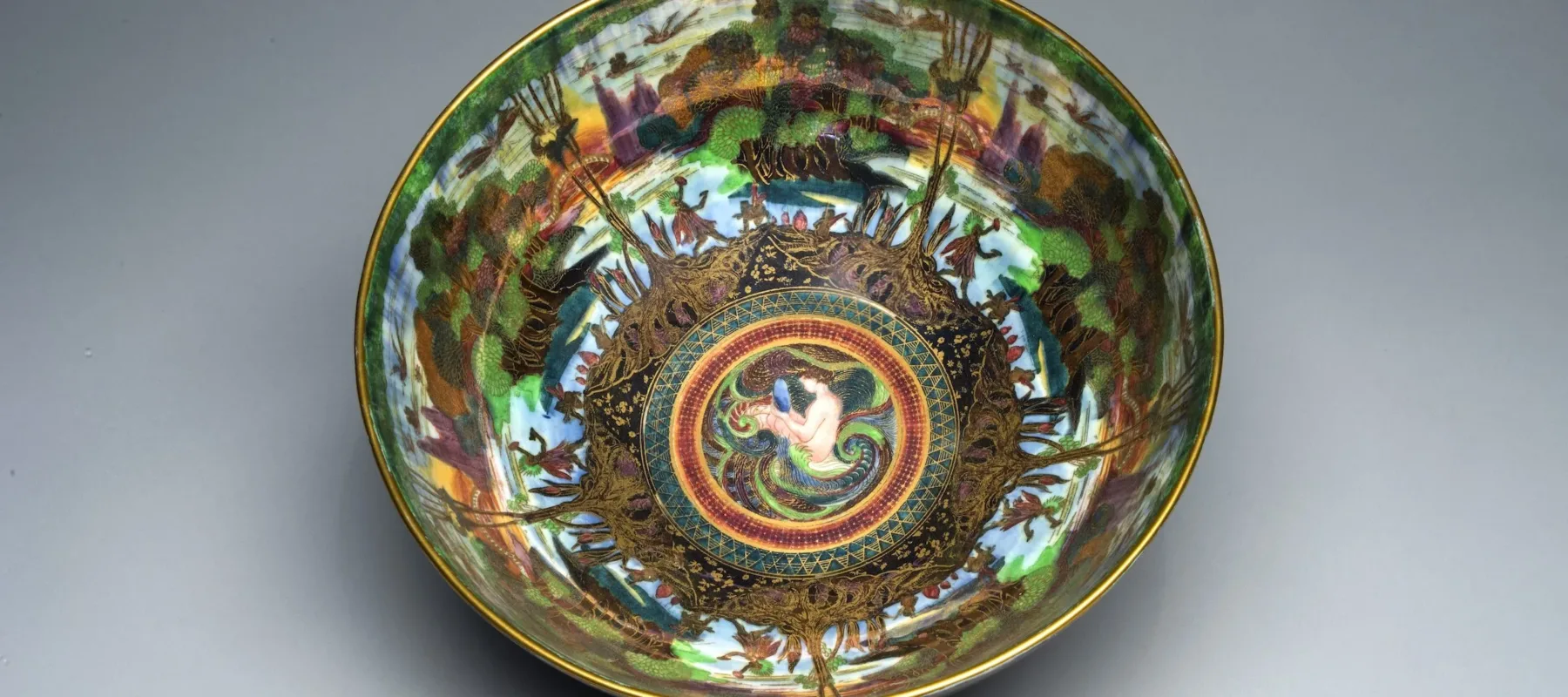WASHINGTON—The National Museum of Women in the Arts (NMWA) presents Casting a Spell: Ceramics by Daisy Makeig-Jones, on view May 1–Aug.16, 2015. This spotlight exhibition presents 38 ceramic pieces by early 20th-century designer Daisy Makeig-Jones (1881–1945) on loan from a private collection, featuring fairies, imps and goblins arrayed on bowls, vases, cups and boxes. Her design innovations, including signature iridescent glazes, exemplify her ingenuity and market savvy among early modern women designers. Casting a Spell reflects upon the artist’s place in the history of decorative arts as well as her identity as a modern woman and artist.
Employed as a designer at the Wedgwood pottery company from 1909 to 1931, Makeig-Jones melded technical ingenuity with vivid imagination to develop decorative china called lusterware. When she joined Wedgwood, women represented about half the employees within the British pottery industry.
“Women were thought to be suited for both designing wares, because of their purported proclivity for nature-based motifs, and crafting pottery, due to their perceived dexterity,” said curatorial assistant Stephanie Midon. “Makeig-Jones’s bold designs and forthright manner set her apart, regardless of gender.” Makeig-Jones—a distinctive character who created distinguished work—had a career at Wedgwood marked by her inventive vision and technical know-how.
Born in Yorkshire, England, to a middle-class family, Makeig-Jones attended Torquay School of Art in southwestern England. At the suggestion of a relative, she introduced herself to Cecil Wedgwood, a partner in the company, and began an apprenticeship there in 1909. She became a lead designer with Wedgwood in 1914 and experimented in both production and design, specializing in lusterware—pottery with metallic glazes. Combining jewel-like colors with motifs primarily inspired by contemporary fairy tale illustrations, Makeig-Jones’s Fairyland Lusterware won her critical and commercial success.
Makeig-Jones adapted motifs from book illustrators such as Kay Nielsen and Edmund Dulac and created elaborate patterns from figures, landscapes and abstract elements. The imps in the most frequently produced fairyland motif known as “Imps on a Bridge and Tree House” bear a strong resemblance to Kewpies, the contemporaneous baby Cupid characters created by American illustrator Rose O’Neill.
In addition to Art Nouveau sources, the popularity of Asian aesthetics and pottery shapes among early 20th-century collectors likely inspired Makeig-Jones. A grand staircase illuminated by two shining torches leading to an Arabian-inspired palace is the motif of a cylindrical vase in the exhibition. The staircase is flanked by tall trees with a bright green serpent-like animal coiled around each trunk. The inner rim and foot are ornamented with the “Flaming Wheel” pattern in blue and green. Asian-inspired adornments also appear in a heavily gilded coral-and-bronze octagonal bowl.
To transfer her designs to the large number of wares produced by Wedgwood, Makeig-Jones depended on the technical skills of the company’s all-female corps of “paintresses,” artisans who applied the vivid glazes to Fairyland Lusterware objects. Engraved onto copper plates, her designs were printed on tissue paper that the paintresses used to transfer images to the ceramic vessels. Particularly on larger objects, Makeig-Jones often combined multiple patterns to create complex designs.
Fairyland Lusterware production was divided into eight color schemes, with four corresponding to types of natural light. Palettes include daylight, depicted with an open sky or a background of mother-of-pearl luster over a wash of color; night (or “Black Fairyland”), with a black background and iridescent sheen; sunset, with fiery oranges and brilliant greens and blues; and moonlight, with a cool color scheme. Casting a Spell features examples of all four natural light color schemes. Highlights include a “Daylight Fairyland” square flower vase with the pattern “Castle on a Road” and a “Sunset Fairyland” punch bowl depicting elves and fairies flitting around a thicket of tree trunks. To achieve an especially dramatic effect, Makeig-Jones occasionally paired two color schemes within one vessel. A punch bowl displays the “Poplar Trees” design in the “Black Fairyland” palette on its exterior and the “Woodland Bridge” design in the soft “Daylight Fairyland” palette on the interior.
Casting a Spell: Ceramics by Daisy-Makeig-Jones is organized by the National Museum of Women in the Arts and is generously supported by the members of NMWA.
National Museum of Women in the Arts
Founded in 1981 and opened in 1987, NMWA is the only museum solely dedicated to celebrating the achievements of women in the visual, performing and literary arts. The museum’s collection features 4,500 works from the 16th century to the present created by more than 1,000 artists, including Mary Cassatt, Frida Kahlo, Alma Thomas, Lee Krasner, Louise Bourgeois, Chakaia Booker and Nan Goldin, along with special collections of 18th-century silver tableware and botanical prints. NMWA is located at 1250 New York Avenue, NW, Washington, D.C., in a landmark building near the White House. It is open Monday–Saturday, 10 a.m.–5 p.m. and Sunday, noon–5 p.m. For information, call 202-783-5000 or visit www.nmwa.org. Admission is $10 for adults, $8 for visitors 65 and over and students, and free for NMWA Members and youths 18 and under. Free Community Days are on the first Sunday of the month. For more information about NMWA, visit www.nmwa.org, Broad Strokes Blog, Facebook or Twitter.
